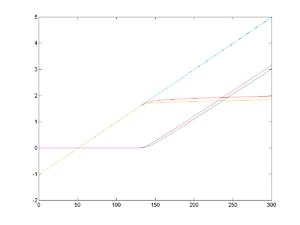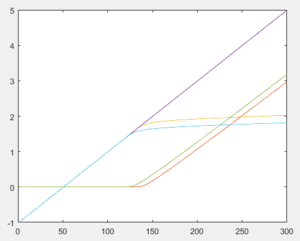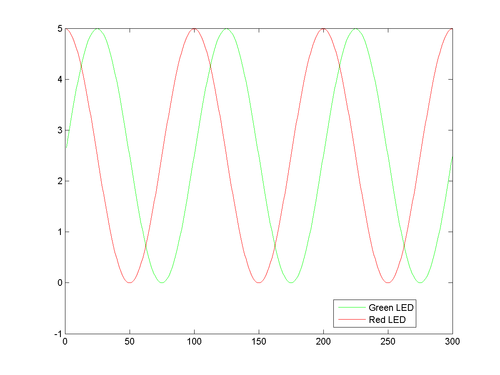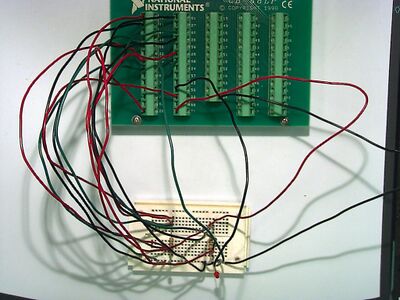EGR 103/DAQ 2 Old
This page contains pictures and graphs related to DAQ 2 for EGR 103. It has been updated for Spring 2017.
Contents
Notes
As before, if the system seems to not recognize Dev1, try Dev2 instead.
Pauses
There are pause commands in the code which will cause the program to...pause - specifically when the program first runs to check the lights. You will need to hit a key to un-pause the program. The way to see if the program is paused is to look at the bottom left corner of your MATLAB window - it will tell you if it is paused.
Graph Labels
For this particular assignment, you do not need axis labels. You need a title on each subplot, however.
Circuit for BasicAOutput
Circuit layout for BasicAOutput.
Circuit for BasicAIO
Circuit layout for BasicAIO (two measurements).
Graph from BasicAIO
Graph showing outputs when
Vout0 = 2.5+2.5*sin(2*pi*k/100);
Vout1 = 2.5+2.5*cos(2*pi*k/100);
That is,
\( \begin{align} V_{out,\,0}=2.5+2.5\sin\left(\frac{2\pi k}{100}\right)\\ V_{out,\,1}=2.5+2.5\cos\left(\frac{2\pi k}{100}\right) \end{align} \)
Circuit for AIO
Circuit layout for AIO (six measurements).
Graph from AIO
Graph showing outputs from six measurement channels. Note at the far left that they all start at either exactly -1 V or 0 V!
Old colors: Blue Green Red Cyan Magenta Yellow
Cyan is on top of blue

New Colors: Blue Orange Yellow Purple Green Cyan
Purple is on top of blue

Codes
Pasting codes from PDF files is...a bad idea. Here are the text versions of some of the codes in the assignment.
BasicAOutput.m
% Clear out workspace
clear
% Clear out DAQ objects
delete(daqfind)
% Create Analog Output Object
AO = analogoutput('nidaq', 'Dev1');
% Change sample rate
set(AO, 'SampleRate', 500);
% View Analog Output Object
AO
% Add channels to Analog Output Object
addchannel(AO, [0 1])
% Write values to output channels
putsample(AO, [5 5])
pause
putsample(AO, [0 0])
% Use loop to set several different voltages
for k=1:300
% Calculate voltages for each channel
Vout0 = 2.5+2.5*sin(2*pi*k/100);
Vout1 = 2.5+2.5*cos(2*pi*k/100);
% Put voltages to each output channel
putsample(AO, [Vout0 Vout1])
% leave line 31 blank for now
% leave line 32 blank for now
pause(0.02)
end
% Turn all outputs off
putsample(AO, [0 0])
BasicAIO.m
% Clear out workspace
clear
% Clear out DAQ objects
delete(daqfind)
% Create Analog Output Object
AO = analogoutput('nidaq', 'Dev1');
% Change sample rate
set(AO, 'SampleRate', 500);
% View Analog Output Object
AO
% Add channels to Analog Output Object
addchannel(AO, [0 1])
% Create Analog Input Object
AI = analoginput('nidaq', 'Dev1')
% Add channels to Analog Input Object
addchannel(AI, [0 4])
% Write values to output channels
putsample(AO, [5 5])
pause
putsample(AO, [0 0])
% Use loop to set several different voltages
for k=1:300
% Calculate voltages for each channel
Vout0 = 2.5+2.5*sin(2*pi*k/100);
Vout1 = 2.5+2.5*cos(2*pi*k/100);
% Put voltages to each output channel
putsample(AO, [Vout0 Vout1])
% Read voltages from all input channels
Voltages(k,:) = getsample(AI);
pause(0.02)
end
% Plot voltages versus index
n = 1:k;
Vleft = Voltages(:,1);
Vright = Voltages(:,2);
plot(n, Vleft, 'g', n, Vright, 'r')
legend('Green LED', 'Red LED', 'location', 'best')
% Turn all outputs off
putsample(AO, [0 0])
Function to Plot Curves
function CurvePlotter(Vin, MyAdjective)
subplot(1, 2, 1)
plot(Vin(:,1), Vin(:,1), 'k-',...
Vin(:,1), Vin(:,2), 'b-',...
Vin(:,1), Vin(:,3), 'g-')
axis([-1 5 -1 5])
grid on
title(sprintf('%s Green', MyAdjective))
subplot(1, 2, 2)
plot(Vin(:,4), Vin(:,4), 'k-',...
Vin(:,4), Vin(:,5), 'm-',...
Vin(:,4), Vin(:,6), 'r-')
axis([-1 5 -1 5])
grid on
title(sprintf('%s Red', MyAdjective))
Script to Plot All Three Figures
clear
% Small LEDs
load SmallData
figure(1); clf
CurvePlotter(Voltages, 'Small')
print -dpng SmallPlot % This will make SmallPlot.png
% Large LEDs
%% your code here
% Rectangular LEDs
%% your code here
Questions
Post your questions by editing the discussion page of this article. Edit the page, then scroll to the bottom and add a question by putting in the characters *{{Q}}, followed by your question and finally your signature (with four tildes, i.e. ~~~~). Using the {{Q}} will automatically put the page in the category of pages with questions - other editors hoping to help out can then go to that category page to see where the questions are. See the page for Template:Q for details and examples.



